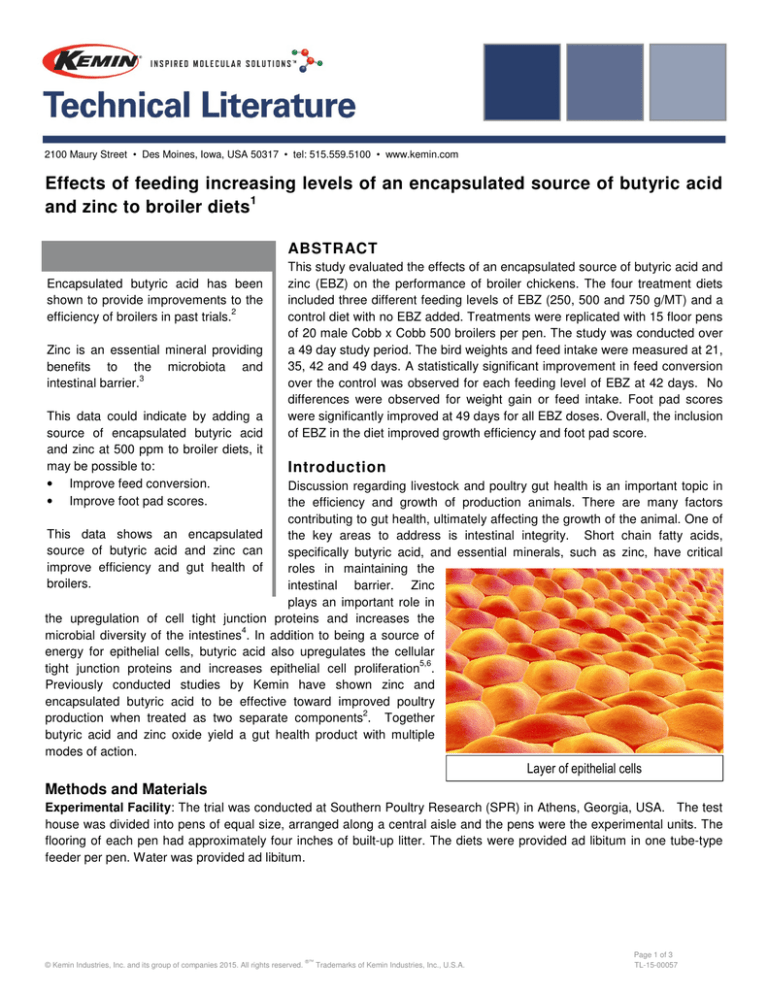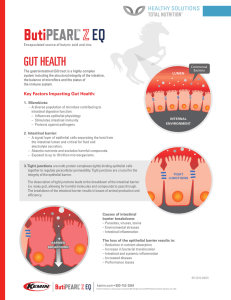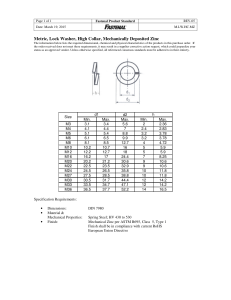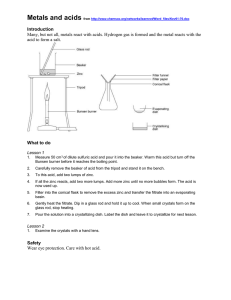
2100 Maury Street • Des Moines, Iowa, USA 50317 • tel: 515.559.5100 • www.kemin.com
Effects of feeding increasing levels of an encapsulated source of butyric acid
and zinc to broiler diets1
ABSTRACT
Encapsulated butyric acid has been
shown to provide improvements to the
2
efficiency of broilers in past trials.
Zinc is an essential mineral providing
benefits to the microbiota and
3
intestinal barrier.
This data could indicate by adding a
source of encapsulated butyric acid
and zinc at 500 ppm to broiler diets, it
may be possible to:
• Improve feed conversion.
• Improve foot pad scores.
This study evaluated the effects of an encapsulated source of butyric acid and
zinc (EBZ) on the performance of broiler chickens. The four treatment diets
included three different feeding levels of EBZ (250, 500 and 750 g/MT) and a
control diet with no EBZ added. Treatments were replicated with 15 floor pens
of 20 male Cobb x Cobb 500 broilers per pen. The study was conducted over
a 49 day study period. The bird weights and feed intake were measured at 21,
35, 42 and 49 days. A statistically significant improvement in feed conversion
over the control was observed for each feeding level of EBZ at 42 days. No
differences were observed for weight gain or feed intake. Foot pad scores
were significantly improved at 49 days for all EBZ doses. Overall, the inclusion
of EBZ in the diet improved growth efficiency and foot pad score.
Introduction
Discussion regarding livestock and poultry gut health is an important topic in
the efficiency and growth of production animals. There are many factors
contributing to gut health, ultimately affecting the growth of the animal. One of
This data shows an encapsulated
the key areas to address is intestinal integrity. Short chain fatty acids,
source of butyric acid and zinc can
specifically butyric acid, and essential minerals, such as zinc, have critical
improve efficiency and gut health of
roles in maintaining the
broilers.
intestinal barrier. Zinc
plays an important role in
the upregulation of cell tight junction proteins and increases the
4
microbial diversity of the intestines . In addition to being a source of
energy for epithelial cells, butyric acid also upregulates the cellular
5,6
tight junction proteins and increases epithelial cell proliferation .
Previously conducted studies by Kemin have shown zinc and
encapsulated butyric acid to be effective toward improved poultry
2
production when treated as two separate components . Together
butyric acid and zinc oxide yield a gut health product with multiple
modes of action.
Layer of epithelial cells
Methods and Materials
Experimental Facility: The trial was conducted at Southern Poultry Research (SPR) in Athens, Georgia, USA. The test
house was divided into pens of equal size, arranged along a central aisle and the pens were the experimental units. The
flooring of each pen had approximately four inches of built-up litter. The diets were provided ad libitum in one tube-type
feeder per pen. Water was provided ad libitum.
© Kemin Industries, Inc. and its group of companies 2015. All rights reserved.
®™
Trademarks of Kemin Industries, Inc., U.S.A.
Page 1 of 3
TL-15-00057
2100 Maury Street • Des Moines, Iowa, USA 50317 • tel: 515.559.5100 • www.kemin.com
Diet Formulation: The birds were fed a medicated
corn-soybean based pelleted diet. The diets were
formulated for three growth phases, starter, grower and
®
finisher. All treatments contained BioCox (50 g/t),
®
®
BMD (50 g/t) and Ronozyme P Phytase (0.019%).
The basal diets contained 29 ppm of Zn from inorganic
sources which came through the premix formulation
used by the University of Georgia.
Treatments: The experiment consisted of 60 pens of
20 male Cobb × Cobb 500 broiler chicks. The
treatments were replicated in 15 blocks; the 4
treatments were randomized within each block.
Treatments 2-4 (Table 1) were made including
encapsulated butyric acid and zinc (EBZ).
Table1. Treatments used
Treatment
Description
1
Control
2
250 g/MT EBZ
3
500 g/MT EBZ
4
750 g/MT EBZ
Trial Setup and Performance Parameters: The total
trial length was 49 days. Starter feed was fed from day
of trial (DOT) 0 to 21. Grower feed was fed from DOT
21-35 and finisher feed was fed DOT 35-49. The feed
was weighed by pen. Means for pen weight gain, feed
consumption, and feed conversion ratio (FCR) were
then calculated for the following time periods: Day 0-21, 0-35, 0-42 and 0-49. FCR was adjusted to account for mortality
occurring during the study.
Results
Adding an encapsulated source of butyric acid and zinc oxide to the broiler diets provided an improvement in feed
conversion at each feeding level throughout the duration of the trial. At 42 days, statistically significant improvements were
observed for all three EBZ feeding levels vs the control. There were no differences between the zinc levels with the most
numerical improvement at the 750 g/MT level as shown in Figure 1. Foot pad scores were also measured on the last day
of the trial. Food pad scores showed a statistical reduction of scores, as compared to the birds fed the control diet as
shown in Figure 2. This suggests a drier excreta may lead to fewer lesions on the feet of birds.
© Kemin Industries, Inc. and its group of companies 2015. All rights reserved.
®™
Trademarks of Kemin Industries, Inc., U.S.A.
Page 2 of 3
TL-15-00057
2100 Maury Street • Des Moines, Iowa, USA 50317 • tel: 515.559.5100 • www.kemin.com
CONCLUSIONS
Feeding broiler diets a source of encapsulated butyric acid in combination with zinc resulted in improvements in FCR and
foot pad scores in one study. This could be a result of a healthier GI tract, leading to drier litter in the house, potentially
improving foot pad scores for the birds in this study.
References
1. Kemin Internal Document, 15-00101.
2. Kemin Internal Document, 12-00035.
3. Katouli M, et al. The effect of zinc oxide supplementation on the stability of the intestinal ora with special reference to
composition of coliforms in weaned pigs. 1999. J of Applied Microbiology. 87:564–573
4. Zhang B, et al. Zinc prevents Salmonella enterica serovar Typhimurium-induced loss of intestinal mucosal barrier
function in broiler chickens. 2012. Avian Pathology. 41: 361-367.
5. Peng L, et al. Butyrate Enhances the Intestinal Barrier by Facilitating Tight Junction Assembly via Activation of AMPActivated Protein Kinase in Caco-2 Cell Monolayers. 2009. J. Nutr. 139:1619-1625.
6. Kotunia A, et al.Effect of sodium butyrate on the small intestine development in neonatal piglets fed by arti-cial sow. J
Physiol Pharmacol. 2004. 55: 59-68.
BioCox® is a registered trademark of Zoetis, Inc.
BMD® is a registered trademark of Zoetis, Inc.
Ronozyme P® is a registered trademark of DSM International Products, LLC.
© Kemin Industries, Inc. and its group of companies 2015. All rights reserved.
®™
Trademarks of Kemin Industries, Inc., U.S.A.
Page 3 of 3
TL-15-00057




